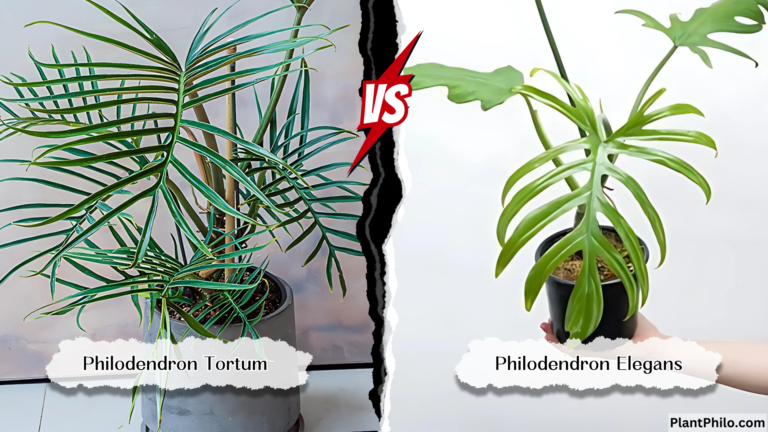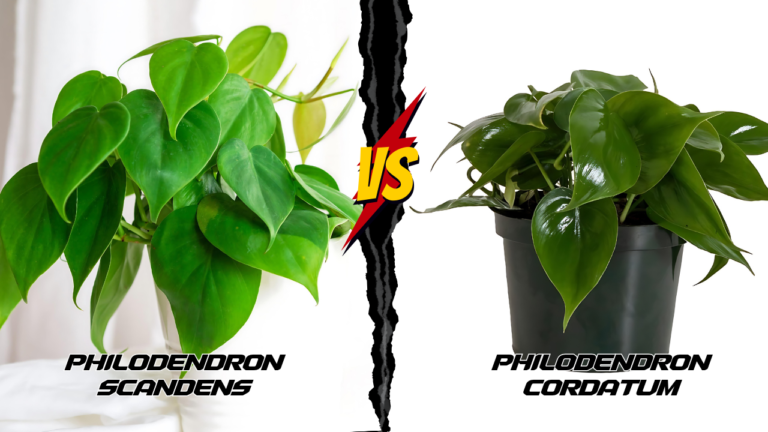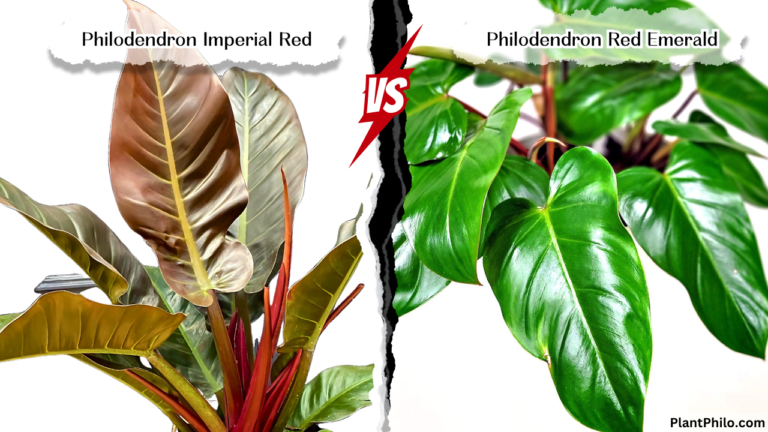Comparison Between Philodendron Glorious and Gloriosum: What’s the Difference?
If you’re eyeing a Philodendron with leaves so plush you want to cuddle them, you’re probably torn between Glorious and Gloriosum. But fear not, plant parent-to-be, this guide will help you decode their quirks and find your perfect match, whether you’re a climber or a crawler kind of person.
Choosing between Philodendron Glorious and Philodendron Gloriosum can be a challenging decision for plant enthusiasts. Both plants are adored for their striking foliage and unique characteristics, but the main difference is that Philodendron Glorious is a climbing variety, while Philodendron Gloriosum is a terrestrial plant.
This factor alone can significantly influence your decision, so it’s crucial to consider your space and display preferences. By emphasizing the importance of personal preferences, you empower the audience to make a decision that aligns with their unique needs and desires.
Philodendron Glorious is a testament to nature’s artistry, known for its smaller, lighter green leaves and rapid growth. It’s an ideal choice if you’re looking for a plant that can swiftly cover a trellis or moss pole.
In contrast, Philodendron Gloriosum is a lush, ground-dwelling beauty with large, heart-shaped leaves that boast a velvety texture and prominent veins. Its visual appeal is equally breathtaking, capturing the hearts of plant enthusiasts.
Rest assured, both plants are relatively easy to care for, making them suitable for beginners and experts alike. This reassurance should instill a sense of confidence in your ability to care for these plants.
Key Takeaways
- Philodendron Glorious is a climbing plant with smaller, lighter green leaves.
- Philodendron Gloriosum is a terrestrial plant with large, velvety, heart-shaped leaves.
- Consider your space and aesthetic preferences when choosing between these two houseplants.
Comparison Summary at A Glance
| Feature | Philodendron Gloriosum | Philodendron Glorious |
| Origins | Native to Colombia and Ecuador | Hybrid (likely with P. gloriosum parentage) |
| Growth Habit | Creeping/Crawling | Can vary, but tends to climb with support |
| Leaf Shape | Broader, heart-shaped | Similar to Gloriosum, but slightly more elongated |
| Leaf Size | Larger | Can be as large, but sometimes slightly smaller |
| Leaf Texture | Velvety, soft | Velvety, soft |
| Leaf Color | Deep green with prominent white/pale green veins | Similar, but veins may be less prominent |
| New Leaf Color | Bronze/reddish | Lighter green, less pronounced coloration |
| Petiole Shape | Round | Round or slightly flattened |
| Ideal Support | Wide pots, terrariums | Moss pole or trellis (if climbing) |
| Price | Generally lower | Generally higher |
| Availability | More common | Less common |
Additional Notes:
- Leaf Shape & Size: While there are subtle differences, these can be hard to spot, especially in younger plants.
- Petiole Shape: The slightly flattened petiole of Glorious is not always present, so it’s not a foolproof identifier.
- Genetic Testing: The only definitive way to differentiate between the two is through genetic testing.
Background and Origins
Philodendron Glorious and Philodendron Gloriosum are both popular among plant enthusiasts for their beauty and unique qualities. Knowing their backgrounds and origins can help you appreciate these tropical plants more.
Philodendron Gloriosum
Philodendron Gloriosum is a creeping plant native to Colombia and Ecuador. It thrives in tropical climates and is known for its stunning, heart-shaped leaves. These leaves are large and velvety with prominent white or cream-colored veins.
The plant is a terrestrial grower, meaning it creeps along the ground rather than climbing trees. This growth habit sets it apart from many other Philodendrons. Experienced collectors often highlight its easy-to-care-for nature, making it a favorite among beginners and experts alike.
Philodendron Glorious
Philodendron Glorious is a hybrid, a cross between Philodendron Melanochrysum and Philodendron Gloriosum. It combines the most attractive features of both parent plants.
This plant has smaller, lighter green leaves compared to the Gloriosum, and these leaves also have a velvety texture. The veins are bright white, creating a striking contrast. An experienced plant expert noted, “Philodendron Glorious is perfect for those who want the beauty of Gloriosum with a bit more manageable size.”
You’ll often find this hybrid in tropical houseplant collections due to its unique beauty and relatively easy care requirements. Its compact size makes it a great choice for indoor spaces.
Visual Comparison: Leaves
When comparing the leaves of Philodendron Glorious and Gloriosum, you will notice differences in shape, size, texture, color, new leaf color, and petioles. Each plant has distinct features that are important for any plant lover to recognize.
Shape
Philodendron Glorious leaves are generally more elongated and oval-shaped. You might see them covering a trellis or moss pole easily. In contrast, Philodendron Gloriosum has classic heart-shaped leaves, which are often wider and give a more traditional philodendron look.
An experienced collector mentioned, “You can usually tell the shape difference even when the plants are young.” So, shape is a key identifier between these two plants.
Size
The leaves on a Philodendron Glorious can grow quite large, with some reaching up to 2 feet in length. This rapid growth rate allows them to quickly fill up space and create a lush environment.
On the other hand, leaves on a Philodendron Gloriosum tend to be a bit smaller but can still get substantial, usually around 18 inches long. Their size makes them a striking indoor plant without overwhelming a space.
Texture
Philodendron Glorious leaves are smooth and often have a slightly glossy appearance. This sheen can make them look very vibrant and healthy. You can easily spot this texture if you look closely under different lighting conditions.
Philodendron Gloriosum, however, has a velvety texture. The leaves feel soft to the touch, which adds an interesting tactile element to the plant. This difference in texture is one of the main ways to tell these plants apart.
Color
Philodendron Glorious tends to have very dark green leaves with some variety in shades, depending on the light they receive. This dark green pairs well with its glossy finish, giving a bold look.
Philodendron Gloriosum’s leaves are often a lighter green and feature prominent white veins. The contrast between the leaf color and the veins makes Gloriosum a favorite among collectors who appreciate detailed foliage.
New Leaf Color
New leaves on a Philodendron Glorious often emerge in a lighter green color before darkening as they mature. This change can add an interesting dynamic to the plant as you watch new growth.
In comparison, new leaves on a Philodendron Gloriosum typically start with a reddish or pink hue before turning green. This color transition is highly appealing and makes each new leaf an exciting event for plant enthusiasts.
Petioles (Leaf Stalks)
Philodendron Glorious features round petioles. This is a subtle but distinct feature that makes it easier to identify if you are having trouble.
Philodendron Gloriosum’s petioles are ‘D’-shaped, where the flat side typically faces outward. This unique petiole shape is a sure-fire way to tell it apart from its cousin when you’re examining the plant up close.
Growth Habit and Structure
If you’re trying to distinguish between Philodendron Glorious and Gloriosum, paying close attention to their growth habits and structures is key.
Philodendron Gloriosum
Philodendron Gloriosum is a terrestrial plant, meaning it grows along the ground rather than climbing. Its growth habit is characterized by its creeping, crawling nature. The leaves are large, heart-shaped, and velvety, with prominent white veins that make a striking pattern.
The petioles of Gloriosum are ‘D’ shaped, which is a helpful identifier. This plant prefers wide but shallow pots to accommodate its unique spread. Keeping it in soil with good drainage helps avoid what experts call “wet feet,” which can harm the plant. It thrives in bright, indirect light and well-draining soil.
Philodendron Glorious
Philodendron Glorious, on the other hand, is a climber. It uses its aerial roots to climb, making it quite different from the crawling Gloriosum. Its leaves are also large and velvety but tend to be more elongated. The petioles of Glorious are round, setting it apart from the Gloriosum.
Glorious grows well with a support, such as a moss pole, to climb on. This plant also prefers bright, indirect light and a loose, well-draining potting mix. Experienced collectors often suggest repotting into taller, narrower pots to support its climbing nature.
Care Requirements
Taking good care of Philodendron Glorious and Gloriosum involves understanding their needs for light, water, humidity, temperature, soil, and pH levels. Each of these factors plays a role in keeping your plants healthy and thriving.
Light
Philodendron Glorious and Gloriosum thrive in bright, indirect light. Direct sunlight can scorch their leaves, so place them in a spot where they can get plenty of filtered light. Placing them near an east or west-facing window is often ideal.
In low light conditions, the growth of these plants can slow down. Using sheer curtains to diffuse light can help achieve the perfect lighting conditions. An experienced plant enthusiast says, “Ensuring they receive enough indirect light can make a big difference in their growth and appearance.”
Water
Both Philodendron Glorious and Gloriosum prefer to stay moderately moist. It’s crucial not to let the soil dry out completely between waterings. Typically, you should water them when the top inch of soil feels dry to the touch.
Overwatering can lead to root rot, which can be fatal for these plants. Use a pot with drainage holes to help avoid waterlogging. A reliable piece of advice from collectors is to “Always check soil moisture before watering to prevent overwatering.”
Humidity
High humidity levels are essential for both Philodendron Glorious and Gloriosum. These tropical plants prefer humidity levels of 60% or higher. If your indoor environment is dry, you might need a humidifier or to frequently mist the plants.
Placing the plants on a tray of wet pebbles can also help increase humidity around them. “Creating a humid microenvironment can greatly improve leaf quality,” notes a passionate grower.
Temperature
These plants do best in temperatures ranging from 65°F to 80°F. They are sensitive to cold drafts and sudden temperature changes, which can cause stress and damage.
Avoid placing them near windows or doors where they might be exposed to cold air in winter. Someone once said, “Keeping a stable temperature is key to preventing shock and ensuring steady growth.”
Soil
Well-draining soil is vital for Philodendron Glorious and Gloriosum. They thrive in a mix that retains some moisture but doesn’t stay soggy. A common mix includes peat, perlite, and a bit of compost.
The soil should allow air to reach the roots to prevent rot. An expert suggests, “Using a high-quality aroid mix can offer the right balance of moisture retention and drainage.”
pH Level
The ideal pH level for Philodendron Glorious and Gloriosum is between 5.5 and 6.5. This slightly acidic range ensures nutrients are available for uptake by the plant’s roots.
Test the soil pH occasionally and adjust it if necessary. A gardening expert recommends, “Using a well-balanced fertilizer can help maintain the right pH level while providing essential nutrients.”
Additional Differentiating Factors
When choosing between Philodendron Glorious and Gloriosum, several factors such as price, availability, petiole details, and genetic testing play crucial roles. These aspects can help you make a more informed decision about which plant to add to your collection.
Price
The price of Philodendron Glorious and Gloriosum can vary significantly. Typically, the Philodendron Glorious tends to be more expensive due to its hybrid nature and unique appeal. You might find Philodendron Glorious listed from $50 to $150, depending on size and condition. In contrast, Philodendron Gloriosum generally ranges from $30 to $100.
Plant prices can fluctuate based on demand, rarity, and the seller. For example, a rare variety of Gloriosum with specific features may cost as much as a more common variety of Glorious. Always compare prices from multiple sellers to ensure you are getting a fair deal.
Availability
Availability of these plants can highly impact your purchase decision. Philodendron Gloriosum is more commonly found and can be easily sourced from local nurseries or online plant stores. It has a wider distribution which makes it accessible for most people.
On the other hand, Philodendron Glorious is often less available due to its hybrid status. Many collectors and nurseries prioritize propagating rare hybrids, making them harder to find. You might need to join plant enthusiast groups or networks to locate a reliable seller.
Petiole Details
One of the primary ways to differentiate these two plants is by examining the petioles. Philodendron Glorious has round petioles, a defining feature that can help you identify it correctly. The round shape is consistent across various growth stages, from young plants to mature specimens.
Philodendron Gloriosum exhibits’ D’-shaped petioles. This characteristic is particularly noticeable when the petiole cross-section is closely observed. The different shapes in petioles serve as a quick reference for distinguishing these plants, especially if their leaves are similar.
Genetic Testing
Genetic testing can offer conclusive identification of Philodendron species. If you are unsure about the plant’s identity, genetic testing can clarify whether you have a Glorious or Gloriosum. This method, although more expensive and technical, provides precise results.
Certified labs can perform these tests, and the results can be trusted to settle any confusion. Expert plant collectors often use genetic testing for rare and expensive plants to ensure authenticity. This extra step can significantly affect the value and care requirements of the plant you own.
Choosing the Right Plant for You
Deciding between Philodendron Glorious and Gloriosum depends on your space, personal preference, and budget. Each plant has unique characteristics that can better suit different environments and tastes.
Space
When selecting a plant, think about the space where you’ll place it. Philodendron Glorious is a climbing variety, meaning it will need vertical support like a trellis. This can make it an eye-catching focal point in a room. If you have a tall spot with indirect light, this might be the perfect plant for you.
On the other hand, Philodendron Gloriosum is a terrestrial plant. It grows horizontally and spreads along the ground. Choose this one if you have ample floor space or a wide, low planter. Because it doesn’t climb, it can be easier to manage in more confined vertical spaces.
Personal Preference
Do you prefer a creeping plant or something that can climb? Your answer will guide your choice. Philodendron Glorious, with its potential to climb, offers a dynamic look. Its leaves are smaller and lighter green, providing a delicate, airy feel. Enthusiasts often describe it as more elegant due to its climbing manner.
If you like the idea of a lush, floor-spreading plant, then Philodendron Gloriosum is for you. It boasts larger, darker green leaves that create a bold, tropical look. Collectors often admire its veiny, heart-shaped leaves, saying they “bring a jungle vibe” into their homes.
Budget
Your budget is also an important factor. Generally, hybrid plants like Philodendron Glorious may be more expensive due to their unique breeding. If cost is a concern, remember that the Glorious might require extra investment in vertical supports and possibly more frequent trimming.
Philodendron Gloriosum, being a naturally occurring species, might be less pricey and easier to find. It usually needs fewer specialized supports, which can save you additional costs. This plant could be a better option if you want to start with a lower budget and expand your collection later.
Frequently Asked Questions
There are several key differences and similarities between Philodendron Glorious and Gloriosum, including their growth habits, size potential, and care requirements.
Can the Philodendron Glorious and Gloriosum be differentiated by their growth habits?
Yes, Philodendron Glorious is a climber, while Philodendron Gloriosum is a crawler. This means that Glorious likes to grow upward, often needing support like a moss pole. In contrast, Gloriosum spreads horizontally across the soil.
How does the size potential vary between Philodendron Glorious and Gloriosum?
Philodendron Gloriosum generally has larger leaves compared to Philodendron Glorious. Gloriosum leaves can grow quite big, giving it a bold presence. Meanwhile, Glorious has slightly smaller, more elongated leaves, which are still impressive but not as large as Gloriosum’s.
Are there distinct care requirements for Philodendron Glorious compared to Gloriosum?
Both plants thrive in high humidity and need well-draining soil. Watering routines are similar too; they prefer their soil to dry out between waterings. A key difference is that Glorious can benefit from climbing support, while Gloriosum needs space to spread out horizontally.
What are the visual differences between Philodendron Glorious and Gloriosum’s leaves?
The leaves of Philodendron Glorious are narrower and longer due to its Melanochrysum parentage. In contrast, Philodendron Gloriosum leaves are broader and have more prominent white veining. This makes Gloriosum stand out more visually.
Can Philodendron Glorious thrive in the same environments as Gloriosum?
Yes, both plants enjoy similar environmental conditions. They both thrive in temperatures between 65-80 degrees Fahrenheit (18-27 degrees Celsius) and high humidity levels between 60% and 80%. Either plant can be an excellent choice for a temperate indoor environment.
How does the Philodendron Glorious hybrid differ genetically from the Gloriosum?
Philodendron Glorious is a hybrid that gets half of its genes from Philodendron Melanochrysum. This hybridization influences its leaf shape and growth habit. In contrast, Gloriosum is not a hybrid and has its own unique set of characteristics, emphasizing its large, velvety leaves and distinct veining.



